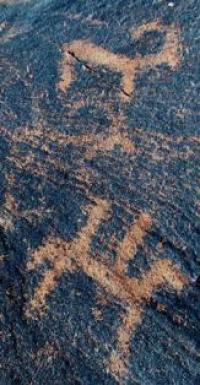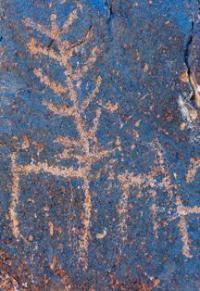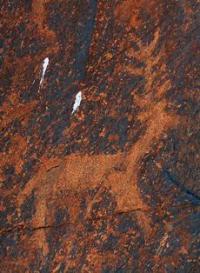Вы здесь
Petroglyphs gorge Taigak.



Sights Petroglyphs in Kazakhstan.
“Take a look at the stone evilly
The gaps in it are strangely deep
A hidden flame flickers beneath the moss;
Do not think, then do not fireflies! "
Nikolai Gumilev. "A rock".
Educational excursions to Kazakhstan petroglyphs.
Groups of petroglyphs were discovered in the Taigak gorge. Rock paintings of Taigak differ significantly both in their location and in the time of their knocking out. Taigak is located 15 km west of the Terekty Gorge.
In the middle part, Taigak is a deep canyon with high rocky walls, along the bottom of which a stream flows. The height of the walls in some places reaches 100 meters. The gorge was overgrown with bushes and trees. It is likely that in ancient times the Taigak gorge was used little for grazing, therefore it is no coincidence that a small number of drawings can be attributed to the period of the ancient nomads.
The main part of the petroglyphs in Taigak are medieval images. Detecting these medieval drawings is quite difficult. Part of the petroglyphs was knocked out on rocky blocks in the depths of the gorge, 4 km above the canyon.
Other groups of drawings stretch along the stream and meet every 3 - 5 km. both on the right and on the left bank. Of greatest interest is the group of drawings, located 7 km up the gorge from the first post of the national park, on the right bank of the stream. Here on a rock is an image of dancing people.
Dancing figures are shown holding hands, they are depicted in two rows. On the right side of the plate are people in short caftans. In the hands of these people large bows were dislocated disproportionately with growth, which served as an occasion for the famous researcher A.Kh. Margulan interpreted these images as musicians playing on plucked instruments.
Between the dancing people on this stage are images of horse riders and fuzzy figures. This whole scene can be attributed to the medieval period, since it was at this time that the tradition of drawing details of clothing in rock paintings spreads.
P.U. Marikovsky, who first discovered the Taigak petroglyphs, believes that the whole composition illustrates the festive effect. The image of a horseman on a deer is carved on the same rock. This is not a plot typical of the Seven Rivers.
One image is known where a sun-headed deity in the tract of Tamgaly is knocked over the figure of a deer, but it belongs to the Bronze Age and is associated with the ideology of another era. In historical literature, there is no information anywhere that in Semirechye, in the Ili River valley, deer were domesticated and could be used for horse riding.
This is probably a mythological plot, well known in the Middle Ages, brought to Zhetysu from the northern regions of Central Asia with the advent of Turkic tribes. It is known that in the 6th century the Türks advanced from Zhetysu to Altai, already in 603 they formed the West Turkic Kaganate led by Daman Kagan.
In Taigak’s medieval petroglyphs, very skillfully executed images are found, for example, a pair of deer - a male and a female. They differ from the Saki style of performance: not two, but all four legs are shown, horns are shown differently.
On the left bank of the stream in a remote place is a group of drawings that allow you to determine the time of the creation of images in the Taigak gorge. First of all, this is an image of two horsemen with banners.
Peaks with bunchuk and banners are spread only in the ancient Turkic period. Images of riders in heavy armor, involving the use of stirrups and special saddles, appear already in the early Middle Ages, but peaks with bunches, along with blankets, sultans and neck brushes are depicted precisely in ancient Turkic times.
Although horse blankets and horse decorations are not depicted on the described scene, they can be dated to the Turkic period according to the style of the image of horses and bunchuk. No less interesting and expressive was the group found in an anhydrous sai adjacent to Taigak from the east.
Here, part of the petroglyphs was knocked out on steep rocks, at an altitude of 20 - 25 meters from the mouth bed. During the inspection of the gorge, archaeologists went through almost the entire gorge and did not find drawings.
Suddenly, in a dry, unpopulated sai on the rocks, several groups with petroglyphs were discovered at once. Deers, goats, argali were carved on the plates. Of particular interest is the scene depicting the battle of two horsemen.
Riders are shown with straight legs, with a straight landing in the saddle, characteristic of warriors in heavy knightly armor, with large peaks. Bunchukes are fixed at the peaks, and bunchukes are different: one
ider has a bunchuk in the form of a frame with three tails, and the second just in the form of a rectangular frame.
The figures of the riders themselves are embossed in the upper part of the large composition, above the large figure of a camel. On the left is another figure of a camel, smaller in size, and on the right a deer and a walking man, probably with weapons, the figures of goats and argali are shown in three rows below.
Symmetrically arranged figures of riders are balanced by images of animals, which gives expressiveness and completeness to the whole composition. Images of horse-drawn standard bearers are well known and are often found in petroglyphs of Kazakhstan, Siberia and Altai.
Similar images are dated as medieval. In Semirechye, only in the Middle Ages they received a wide distribution of stirrups and saddles, which allowed the rider to fight with a heavy long lance. In addition to these main groups of petroglyphs in Taigak, drawings are found in various, often completely unexpected places.
Another small group of drawings seems to be hidden from view, mainly rough coarse images of camels, argali, and sometimes archers. They can be found in some closed rocky circus, in the upper reaches or high on the slopes, 300 - 500 meters from the bottom of the main gorge.
Such images differ in patina color; they are somewhat lighter than medieval ones. Unfortunately, reliable dating features for these individual images have not yet been discovered. Perhaps most of these petroglyphs were deposited on the rocks in the late Middle Ages.
In general, Taigak petroglyphs are peculiar both in plot and in location. They are not grouped and do not constitute a single cult center. Apparently, in the Middle Ages and in subsequent periods, the entire gorge was a kind of sacred protected area.
It is unlikely that the Taigak gorge was actively used for economic purposes. The question arises, why is it that medieval drawings prevail here, how was this place used in the Middle Ages? Perhaps, when using the gorge bed for cult purposes, its isolation, inaccessibility and natural features - high walls of the canyon, streams and small groves were important.
It is known that among the Turkic tribes and clans, individual hills, mountains and groves had sacred significance and were used as natural sanctuaries.
Authority:
The book "Rock paintings of the Seven Rivers", authors: Maryashev AN, Goryachv A.A. second edition revised and expanded, Almaty, 2002.
Photos by
Alexander Petrov.







